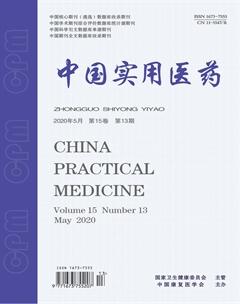抗核抗体与不明原因复发性流产相关性的初步探讨
崔蓉 钟兴明 苗竹林 韩璐 刘晓阳 王永霞


【摘要】 目的 通過分析抗核抗体(ANA)和抗核抗体谱(ANAs)在不明原因复发性流产(URSA)患者血清中的表达情况, 探讨ANA及ANAs与不明原因复发性流产的发生是否具有相关性。方法 选取流产门诊就诊的不明原因复发性流产患者267例作为观察组, 另选取同期有正常妊娠分娩史的女性90例作为对照组。采用化学发光法检测并比较两组血清中ANA和ANAs的阳性情况。结果 观察组血清样本ANA阳性57例, 阳性率为21.35%;对照组血清样本ANA阳性2例, 阳性率为2.22%。两组ANA阳性率比较, 差异有统计学意义(P<0.05)。观察组抗干燥综合征抗原A抗体(SSA)、抗干燥综合征抗原B抗体(SSB)、抗双链DNA抗体(dsDNA)阳性率分别为6.37%(17/267)、0.75%(2/267)、3.00%(8/267), 抗史密斯抗体(Sm)、抗硬皮病70抗体(Scl-70)、抗组氨酰tRNA合成酶抗体(Jo-1)阳性率均为0。对照组SSA阳性率为2.22%(2/90), Sm、SSB、Scl-70、Jo-1、dsDNA阳性率均为0。两组Sm、SSA、SSB、Scl-70、Jo-1、dsDNA阳性率比较, 差异均无统计学意义(P>0.05)。结论 自身抗体ANA和不明原因复发性流产的发生发展有一定的相关性, 临床上可能是反复流产的原因之一, 但具体的机制机理尚需进一步明确。
【关键词】 抗核抗体;抗核抗体谱;不明原因复发性流产
DOI:10.14163/j.cnki.11-5547/r.2020.13.001
Preliminary study on the correlation between antinuclear antibody and unexplained recurrent spontaneous abortion CUI Rong, ZHONG Xing-ming, MIAO Zhu-lin, et al. Guangdong Family Planning Research Institute, Guangzhou 510600, China
【Abstract】 Objective Objective To discuss the correlation between antinuclear antibody (ANA) and antinuclear antibody spectrum (ANAs) and unexplained recurrent abortion by analyzing the expression of ANA and ANAs in the serum of patients with unexplained recurrent spontaneous abortion (URSA). Methods There were 267 patients with unexplained recurrent spontaneous abortion selected as the observation group and
90 women with normal pregnancy and delivery history as the control group. The chemiluminescence method was used to detect and compare the positive status of ANA and ANAs in the two groups of serum. Results The observation group had 57 ANA positive cases, with positive rate as 21.35%. The control group had 2 ANA positive cases, with positive rate as 2.22%. There was statistically significant difference in ANA positive rate between the two groups (P<0.05). The positive rates of anti Sjogrens syndrome antigen A antibody (SSA), anti Sjogrens syndrome antigen B antibody (SSB), anti dsDNA antibody (dsDNA) were 6.37% (17/267), 0.75% (2/267), 3.00% (8/267), and the positive rates of anti Smiths antibody (Sm), anti scleroderma 70 antibody (Scl-70) and anti histidine tRNA synthetase antibody (Jo-1) were 0. The control group had SSA positive rate as 2.22%(2/90), Sm, SSB, Scl-70, Jo-1 and dsDNA positive rate as 0. There was no statistically significant difference in Sm, SSA, SSB, Scl-70, Jo-1, dsDNA postive rate between the two groups (P>0.05). Conclusion There is a certain correlation between ANA and the occurrence and development of unexplained recurrent spontaneous abortion. It may be one of the causes of recurrent abortion in clinic, but the specific mechanism needs to be further clarified.
【Key words】 Antinuclear antibody; Antinuclear antibody spectrum; Unexplained recurrent spontaneous abortion
流产的发生很常见, 人群发病率约为15%~25%。一次流产的发生常常不会引起重视, 然而反复流产对女性及其家庭的伤害却是不可忽略的。国内对不明原因复发性流产的定义是3次或者3次以上的妊娠28周以前的胎儿丢失, 并且同时排除遗传、解剖、内分泌、感染、血栓前状态等原因存在的反复流产称之为不明原因的复发性流产(unexplained recurrent spontaneous abortion, URSA)。对于能找到原因的流产, 临床上有相应的诊疗措施, 通过积极治疗后结局是乐观的。而对于不明原因复发性流产的治疗, 临床上则显得棘手。近年来, 随着生殖免疫学在此问题上的深入研究, 发现免疫性疾病与反复出现的妊娠丢失是有相关性的。目前较为明确的会导致流产反复发生的免疫性疾病有磷脂综合征, 而临床工作中更常见的情况是患者仅有一些自身免疫性抗体的升高, 如抗核抗体(antinuclear antibody, ANA)及其抗核抗体谱(antinuclear antibody spectrum, ANAs), 抗甲状腺抗体, 抗血管炎抗体, 类风湿抗体等, 对于这些免疫性抗体的升高是否会影响妊娠的结局, 国内外已有少量文献报道, 但是结论不一。本研究旨在通过分析ANA及ANAs在不明原因反复流产患者血清中的表达情况, 寻找与流产有关的线索, 为复发性流产的病因查找提供新的思路。
1 资料与方法
1. 1 一般资料 因为自发流产2次的患者其再次发生流产的风险与3次流产史的患者再发流产的风险相近, 故作者选取的研究对象是自发流产≥2次者, 均可入组。选取2017年6月~2018年12月在本院流产门诊就诊的不明原因复发性流产患者267例为观察组, 年龄24~38岁, 所有患者均建立个人流产档案, 并且入选本次研究要求满足:①自然流产≥2次;②无甲状腺疾病, 无糖尿病史, 无妇科内分泌异常;③无解剖結构异常, 无宫腔粘连;④无全身及生殖道感染;⑤无免疫性疾病;⑥夫妻双方染色体正常。并选取同期有正常妊娠分娩史的女性90例作为对照组。两组研究对象的年龄、体质量指数(BMI)、雌二醇(E2)水平等一般资料比较, 差异无统计学意义(P>0.05), 具有可比性。见表1。
1. 2 实验设备及试剂 检测仪器为亚飞龙iFlash 3000-H化学发光免疫分析仪(中国), 相应试剂有: ANA 免疫球蛋白G(IgG)测定试剂盒, 抗史密斯抗体(Sm)IgG测定试剂盒, 抗干燥综合征抗原A抗体(SSA)IgG测定试剂盒, 抗干燥综合征抗原B抗体(SSB)IgG测定试剂盒, 抗硬皮病70抗体(Scl-70)IgG测定试剂盒, 组氨酰tRNA合成酶抗体(Jo-1)IgG测定试剂盒, 抗双链DNA抗体(dsDNA)IgG测定试剂盒。所有操作步骤以及结果判定均严格按仪器及试剂说明书进行。
1. 3 观察指标 所有对象在首诊后第2天上午9点采血, 所获血样本静置30 min, 离心后原管上机。采用化学发光法检测并比较两组血清中ANA和ANAs的阳性情况。
1. 4 统计学方法 采用SPSS22.0统计学软件进行统计分析。计量资料以均数±标准差( x-±s)表示, 采用t检验;计数资料以率(%)表示, 采用χ2检验。P<0.05表示差异具有统计学意义。
2 结果
观察组血清样本ANA阳性57例, 阳性率为21.35%;对照组血清样本ANA阳性2例, 阳性率为2.22%。两组ANA阳性率比较, 差异有统计学意义(P<0.05)。观察组SSA、SSB、dsDNA阳性率分别为6.37%(17/267)、0.75%(2/267)、3.00%(8/267), Sm、Scl-70、Jo-1阳性率均为0。对照组SSA阳性率为2.22%(2/90), Sm、SSB、Scl-70、Jo-1、dsDNA阳性率均为0。两组Sm、SSA、SSB、Scl-70、Jo-1、dsDNA阳性率比较, 差异均无统计学意义(P>0.05)。见表2。
3 讨论
近年来, 随着人们对生殖免疫学的关注, 免疫性疾病在生殖障碍中的作用也越发受到重视。目前已经明确自身免疫性疾病磷脂综合征会引起反复流产的发生, 临床工作中常常会遇到自身免疫性抗体升高, 但还未能诊断为相关免疫性疾病的情况, 也提示了机体自身免疫状态的异常, 这种异常的状态也可能影响到了女性的生殖健康。或许其可以解释复发性流产至今尚有近一半的比例无法找到的原因。ANA又称抗核酸抗原抗体, 是一组对细胞核内的DNA、RNA、蛋白或这些物质的分子复合物产生的自身抗体。而ANAs则是按其核内各个分子的性能不同可将各ANA区分开来。ANA及ANAs是最常用的风湿免疫疾病抗体, 与多种风湿免疫性疾病相关。但在正常人群中, 也有一定的阳性率。它们与不孕症、复发性流产等生殖障碍的相关性, 目前尚无一致的看法[1-4]。
在Mumusoglu等[5]的临床观察中, 自身抗体阳性组流产的发生率明显高于对照组, 认为即便没有免疫性疾病, 自身抗体的存在, 本身也可能直接增加复发性流产和产科并发症的风险。Sakthiswary等[6]在研究中发现, 流产组的ANA阳性率高达35.3%, 认为ANA阳性提示患者妊娠的结局较差。也有文献认为孕前ANA阳性状态对妊娠结局没有影响, 而在妊娠后, 早孕期间ANA转阴对连续妊娠具有良好的预后价值, 认为ANA对流产的发生起到了一定的作用[7]。
还有报道称, 在体外受精-胚胎移植(IVF-ET)中, ANA+/dsDNA+组中检索到的卵母细胞、可用胚胎和高质量胚胎的数量低于对照组中的数量, 植入率和临床妊娠率最低, 早期流产率最高[8, 9]。而使用阿司匹林和泼尼松预处理的ANA阳性的IVF-ET患者, 其受精率、妊娠率、着床率明显高于对照组, 流产率则明显低于对照组[10, 11]。在作者的研究中, 观察组267例不明原因复发性流产患者, 有57例检测到ANA抗体的存在, ANA阳性率为21.35%(57/247), 对照组90例, 检测到ANA阳性2例, 阳性率为2.22%, 两组比较差异具有统计学意义 (P<0.05), 这与以上文献观察结果是一致的。单项抗体阳性率在两组间比较, 差异无统计学意义(P>0.05), 可能和作者的样本量小、抗体种类有限有关。这些研究结果都提示了ANA可能在妊娠发生及早期妊娠阶段不良事件中发挥了作用。最近国内一篇ANA与复发性流产关系的META分析发现:病例组ANA阳性率高于对照组;ANA滴度<1∶100或滴度>1∶100时, 病例组ANA 抗体滴度较对照组高(P<0.05), 但在总体上两组的 ANA 抗体滴度差异无统计学意义(P>0.05), 最后得出结论, ANA阳性可能与复发性流产有关, 但是ANA滴度高低与复发性流产的相关性仍不明确[12]。
文献也发现伴低补体血症的系统性红斑狼疮(SLE)或原发性抗磷脂抗体综合征(APS)合并妊娠者发生流产、早产的风险最高[13, 14]。因此, 作者分析, 虽然没有发生免疫性疾病, 但是机体内的ANA抗体, 可能也激活了母体的补体系统, 补体异常激活, 活化的补体成分趋化招募炎性细胞, 炎性细胞再经多种途径致胎盘血管形成不足、胚胎氧化性损伤, 最后导致流产等妊娠并发症的发生[15-18]。ANA抗体在体内活跃, 引起的炎症反应产生的若干炎性因子也对母胎界面的淋巴细胞亚群的数量和活性起到了一定的促进作用, 母体对胚胎的免疫耐受向免疫排斥方向發生摆动, 诱发妊娠物的丢失, 发生流产[19, 20]。
综上所述, ANA与不明原因复发性流产的发生可能有一定的相关性, 但是具体机理机制尚需进一步研究探讨, 也期望能有更多的大样本的、循证级别更高的临床资料来明确ANA在不明原因复发性流产病因学中的意义。
参考文献
[1] Harger JH, Rabin BS, Marchese SG. The prognostic value of antinuclear antibodies in women with recurrent pregnancy losses: a prospective controlled study. Obstet Gynecol, 1989, 73(3):419-424.
[2] 李翘竹, 李慧芳, 田秀珠. 原因不明习惯性流产患者自身抗体的研究. 中华妇产科杂志, 1998, 33(1):13-16.
[3] Ticconi C, Rotondi F, Veglia M, et al. ntinuclear autoantibodies in women with recurrent pregnancy loss. Am J Reprod Immunol, 2010, 64(6):384-392
[4] Hefler-Frischmuth K, Walch K, Hefler L, et al. Serologic markers of autoimmunity in women with recurrent pregnancy loss. American Journal of Reproductive Immunology, 2017, 77(4):e12635.
[5] Mumusoglu S, Beksac MS, Ekiz A, et al. Does the presence of autoantibodies without autoimmune diseases and hereditary thrombophilia have an effect on recurrent pregnancy loss? Matern Fetal Neonatal Med, 2016, 29(14):2352-2357.
[6] Sakthiswary R, Rajalingam S, Norazman MR, et al. Antinuclear Antibodies predict a higher number of Pregnancy Loss in Unexplained Recurrent Pregnancy Loss. Clin Ter, 2015, 166(2):e98-e101.
[7] Ticconi C, Pietropolli A, Borelli B, et al. Antinuclear autoantibodies and pregnancy outcome in women with unexplained recurrent miscarriage. Am J Reprod Immunol, 2016, 76(5):396-399.
[8] Fan J, Zhong Y, Chen C. Impacts of Anti-dsDNA Antibody on In Vitro Fertilization-Embryo Transfer and Frozen-Thawed Embryo Transfer. J Immunol Res, 2017(2017):8596181.
[9] Girardi G. Complement activation, a threat to pregnancy. Semin Immunopathol, 2018, 40(1):103-111.
[10] Zhu Q, Wu L, Xu B, et al. A retrospective study on IVF/ICSI outcome in patients with anti-nuclear antibodies: the effects of prednisone plus low-dose aspirin adjuvant treatment. Reprod Biol Endocrinol, 2013, 5(11):98.
[11] Fan J, Zhong Y, Chen C. Combined treatment of prednisone and aspirin, starting before ovulation induction, may improve reproductive outcomes in ANA-positive patients. Am J Reprod Immunol, 2016, 76(5):391-395.
[12] 冯郁, 刘博, 杨一华, 等. 抗核抗体阳性与复发性流产关系的Meta分析. 广西医学, 2019, 41(14):1808-1812.
[13] De Carolis S, Botta A, Santucci S, et al. Complementemia and obstetric outcome in pregnancy with antiphospholipid syndrome.. Lupus, 2012, 21(7):776-778.
[14] Clowse ME, Magder LS, Petri M. The clinical utility of measuring complement and anti-dsDNA antibodies during pregnancy in patients with systemic lupus erythematosus. J Rheumatol, 2011, 38(6):1012-1016.
[15] 蘇小玲, 赵爱民, 林其德. 补体异常激活在复发性流产中的作用. 国际妇产科学杂志, 2013, 40(4):353-357.
[16] Girardi G. Role of tissue factor in the maternal immunological attack of the embryo in the antiphospholipid syndrome. Clin Rev Allergy Immunol, 2010, 39(3):160-165.
[17] Redecha P, Tilley R, Tencati M, et al. Tissue factor:a link between C5a and neutrophil activation in antiphospholipid antibody induced fetal injury. Blood, 2007, 110(7):2423-2431.
[18] Cohen D, Buurma A, Goemaere NN, et al. Classical complement activation as a footprint for murine and human antiphosphplipid antibody-induced fetal loss. J Pathol, 2011, 225(4):502-511.
[19] Geisert R, Fazleabas A, Lucy M, et al. Interaction of the conceptus and endometrium to establish pregnancy in mammals: role of interleukin 1β. Cell Tissue Res, 2012, 349(3):825-838.
[20] Zhao X, Jiang Y, Wang L, et al. Advances in understanding the immune imbalance between T-lymphocyte subsets and NK cells in recurrent spontaneous abortion. Geburtshilfe Frauenheilkd, 2018, 78(7):677-683.
[收稿日期:2019-10-22]

